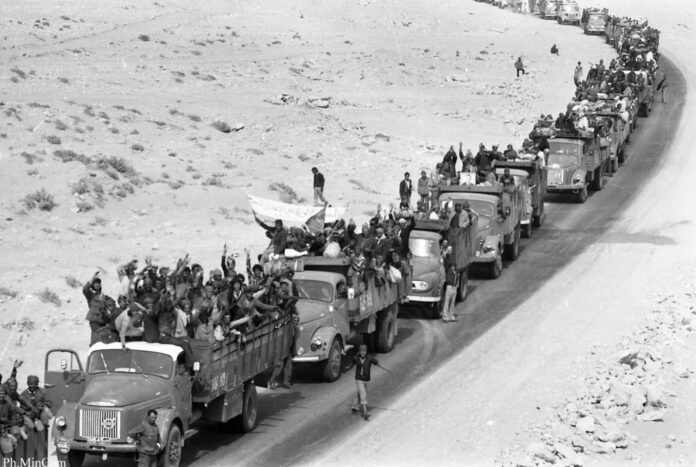Exactly 46-years ago, King Hassan II of Morocco rallied his country’s citizens, urging them to embark on a long, peaceful march to the south, to liberate the Sahara from Spanish occupation.
It is that historic speech – on November 6, 1975 – which heralded the famed Green March, a hitherto unprecedented event in the history of both the 20th century and the African continent. The result? A strong gathering of 350,000 volunteers which eventually brought down the walls of Spanish occupation without resorting to violence!
A senior Moroccan official close to the Sahara file said: “The recourse of the kingdom to the peaceful green march symbolizes its unwavering commitment to dialogue for the resolution of territorial disputes inherited from the colonial era and that its organization was preceded by a long process, so that Morocco recovers its land peacefully and through the implementation of a negotiation approach”.
About 45 years earlier, Mahatma Gandhi had launched India’s Salt March and set the stage for the wrestling of the Asian country’s independence from British occupation. On the occasion of the anniversary of the Green March, we look back upon the events of two historic moments, when peaceful actions pulled apart by geography helped change the destiny of a Nation.
There can be little gainsaying the fact that Morocco’s spectacular action does have some similarities with the “Salt March”, also known as the Salt Satyagraha, Dandi March and the Dandi Satyagraha, which Gandhi launched on on March 12, 1930, as an act of nonviolent civil disobedience in colonial India, which became the real concretization of his doctrine of non-violence.
It was barely a month earlier – on February 15, 1930, that Gandhi had announced to his companions in the Congress, the Indian independence party that he had chosen as the objective of the civil disobedience campaign the abrogation of a law that forced Indians to pay tax on salt. Back then, it was an offence to make, possess, sell or buy salt. Even taking away natural salt left on a beach was outlawed, but on the morning of March 12, 1930, the then 61-year-old Gandhi left the city of Ahmedabad with 79 companions. They proposed to reach by foot the village of Dandi, 380 kilometers away and at the edge of the Indian Ocean.
The international press covered the event. After 25 days of walking and meetings, Gandhi picks up on the beach a little salt forgotten by the waves.
Although it took more than 17 more years of a painstaking effort for India’s independence to finally dawn on August 15, 1947, the Salt March remains a significant historical event for the Asian country; it became a peaceful harbinger for the subsequent attainment of independence.
On the other hand and more than four decades later, the Moroccan Kingdom began the process of completing its territorial integrity in 1956, the official year of independence. The decolonization of the Western Sahara territory took place in a completely different context from the other decolonization phases of the Moroccan Kingdom.
Franco’s Spain had no intention of retro-ceding the Western Sahara province, mainly because phosphate deposits had been discovered in that region in 1972, while Algeria, aided and abetted by the Eastern bloc, added another layer of resistance, as it laid undeclared claims to the territory.
Algeria rode on the Cold War between the United States of America and the then Soviet Union, as it hoped back then – as it still does today, to set up a republic under its absolute control in the image of the old Syrian/Lebanese governance model.
Perhaps spurred by the Salt March, King Hassan II developed an exceptional idea, which on November 6, 1975, saw him launch his appeal for Moroccans to undertake the long, peaceful march, triggering an immense popular fervor.
The king concluded his speech by asking the Moroccans to be courteous by greeting and inviting to a meal every Spanish person they would meet along the way, adding that he and his fellow citizens did not feel any resentment for the occupiers. He even boldly declared that were they to fight against Spain, they would not hide behind unarmed civilians, but would use military force. He made it known that they were not angling for war because they were reluctant to shed blood.
Of the 350,000 Moroccans who partook in that history-making event, 35,000 women, who chose to join the great trek punctuated by joy and prayer. Dozens of foreign personalities and delegations from different countries also joined the march, with King Hassan II describing the participation of women as a symbol of pacification of the March.
The number of volunteers was not left to chance: it was the number of people born in Morocco every year. It was a real Morocco in a nutshell, where all provinces and social conditions were represented.
Unlike the Salt March in India, the Green March was a real logistical and human challenge for Morocco at the time, as it required the mobilization of 7,800 trucks and other means of transport, 17,000 tons of food, 63,000 tons of water, 5,500 tons of fuel, 500 doctors and health assistants, 220 ambulances, and more than 10,000 people to organize and supervise the 350,000 marchers.
The Green March started from the region of Tarfaya, braving the Spanish military and the barbed wire at the borders. Faced with the determination of the marchers, Spain had no choice but to disengage from the region, concretised by an official letter sent by its permanent representative to the UN on February 26, 1976, after which a handover ceremony was organized between Morocco and Spain.
The Green March and the Salt March, unique in their kind, are national epics characterized by a fierce patriotism that marked the national destinies of the two countries that lie in two different continents: Morocco and India.




